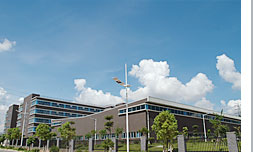|
A water dispenser is a device that dispenses water. Normally they cool and heat water too. They are generally broken up in two categories by water supply: point of use (POU, equally bottleless) water dispensers and bottled water dispensers, in two categories by cooling technology: compressor cooling water dispensers and semiconductor cooling water dispensers.
Bottled water dispensers
Bottled water dispensers have been around since before the middle of the 20th Century. They are designed to allow bottles to stand conversely in specific connections in the top of dispensers (exceptionally some can allow bottles stand upright by using pumps to inhaling water in the reserviors). The bottle size varies with the size of the unit with the larger versions in the US using 5 gallon bottles. The standard size elsewhere is 18.9 litres, and the containers are known in the beverage industry as 'bubble-tops', as bubbles raise and pop as the container fills.
Point of use water dispensers
Point of use water dispensers are plumbed through directly into the mains water supply, optionally with a filtration system, and not requiring bottles.
The bottled water vs tap water debate has shaped the role of point of use (POU) machines in European hotels, restaurants and catering outlets. This is presenting opportunities for the traditionally office-based usage of mains-fed POU water dispensers.
By providing demonstrable cost savings, particularly in high consumption accounts, POU water dispensers have hus become a growth phenomenon. Indeed, the European POU industry has turned a corner, reaching a new level of development upon which significant opportunities can be born. An increasing number of companies are turning their attention to these opportunities. Zenith's latest report tracks the POU activities of more than 300 distributors, with profiles on the top 180.
A recent survey conducted by Zenith International indicates the U.S. market for free-standing POU (point of use) water dispenser machines increased more than 12 percent during the first half of 2006. The total number of bottleless water dispensers in the U.S. now stands at 500,000, according to the survey.
By cooling technology, water dispensers can also be divided into two categories: compressor cooling water dispensers and semiconductor cooling water dispensers. Most people understand compressor cooling as refrigerators and air conditioners are very familiar by us. Then what is semiconductor cooling? It can be called thermoelectric cooling too. The key device is a module - Peltier. Peltier is a miniature solid state heat pump having either a cooling or a heating function. Its principle is a phenomenon called "Peltier Effect" discovered by Peltier in 1834. He discovered that when two metal wires of different materials were joined to form an electrical circuit and a direct electrical current was made to flow through the circuit, one junction became cold and the other junction became hot; when the current direction was reversed, the cold junction got hot while the hot junction got cold. Since then, there have been constant efforts to make use of this principle. Solid state heat pumps became commercially attractive only recently, however, when high performance semi-conductor materials had been developed by early 1960's and the manufacturing technologies of the thermoelectric modules using the materials well developed. The most advantage of compressor cooling water coolers is the quick cooling, but the disadvantage is high cost. Compressor cooling water dispensers are very popular in Europe, North America and some tropical countries. Semiconductor cooling water dispensers cost much less, but features low cooling efficiency.
|


